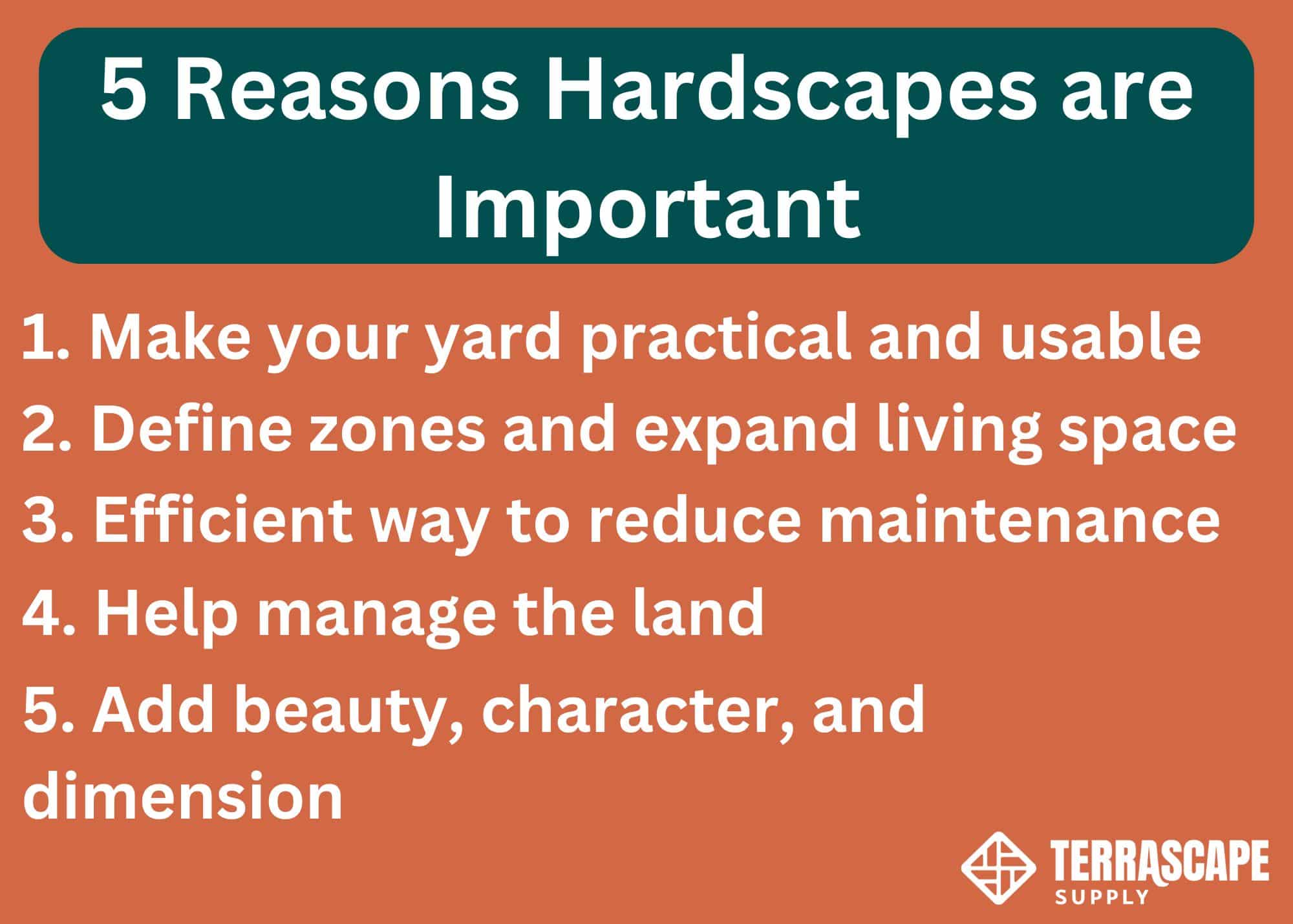From Patios to Pathways: Essential Hardscaping Materials Explained
Close your eyes for a moment. Picture yourself lounging in your backyard with a cool glass of lemonade. Ignore the weedy, half-dead grass; instead, imagine you’re in the most beautiful garden you’ve ever seen.
The garden of your imagination has dimension and charm, wandering pathways and tall trees, burbling fountains, and inviting benches. It has a wide patio with pleasant furniture and a gazebo surrounded by flowers.
Now, back to reality.
How would you begin to make your backyard even half as inviting?
At Terrascape Supply, we talk with people every day who want to turn their landscaping dreams into tangible realities.
The problem?
They’re so focused on softscapes—on flowers, trees, shrubs, and mulch—that they forget about the crucial element of carefully chosen hardscapes.
Pull up a chair, pour yourself a warm cup of coffee, and let’s explore, together, the wonderful world of hardscapes just waiting to be discovered.
What Is Hardscaping?
Let’s go back to the beautiful garden of your imagination. Think about the stone paths winding through the flowers, the charming bench under a shady tree, and the low, mossy wall holding back a bank of earth. Those stones and benches, walls and patios, and even the little pond with its stone edging are all parts of the hardscape.
Like the walls of a cottage, the hoopskirt of a Victorian gown, or the bones in your body, hardscapes provide structure and form for your landscaping.
The hardscape is everything in your yard that's solid and doesn’t change with the seasons. It's made of stones, bricks, wood, metal, concrete, and glass. It's the paths you walk on, the walls that keep your soil in place, and the arches and pergolas where you might hang a lantern or string up lights.
So when planning your landscaping, think about the sturdy things that make your outdoor area a pleasant place to walk, relax in the shade, play with children, or chat with old friends. Carefully choose hardscapes that lend shape and structure to your yard, creating a cozy outdoor area that makes you feel at home.

Hardscaping vs. Softscaping vs. Landscaping
When designing your outdoor space, you may find the terms “hardscaping,” “softscaping,” and “landscaping” to be confusingly similar. Let’s try to understand the difference between these three important garden-centered words.
“Landscaping” describes the craft of shaping the land to make it beautiful and useful. Everything you do to your yard, whether you’re digging a pond, pruning your cherry tree, laying pavers around your fire pit, or planting geraniums, is a form of landscaping.
“Hardscaping” is a more specific word that refers to the structural, unchanging parts of the landscape, such as a rustic wood pavilion or the stone edging on a pond.
“Softscaping,” on the other hand, refers to the living, ever-changing aspects of the landscape. It's the soft grass underfoot, the wisteria climbing the pavilion, the koi fish splashing in the pond, and the shady willow tree. Softscaping involves planting trees and flowers, pruning branches, spreading mulch, and making your garden come alive with color and scent.
The Importance of Hardscaping
Let’s examine the various ways that hardscape materials transform your outdoor space into a peaceful oasis that complements your lifestyle.
Hardscape makes your yard practical and usable
A yard with no hardscapes quickly becomes an impractical muddle. Without well-designed paths to keep your feet dry, your apples will remain unpicked and your flowers neglected. You’ll find it challenging to share your beautiful garden with friends without a patio or gazebo.
Retaining walls, benches, raised beds, and firepits all offer ways to make your outdoor space practical and usable in your everyday life.
Hardscape defines zones and expands living space
Patios, pergolas, and gazebos expand your living space to the great outdoors. On sunny days, these structures allow you to eat, take phone calls, or do paperwork in the beauty of your garden instead of a dark, stuffy house.
Paths, low walls, and fences further define your outdoor space, separating grassy areas suitable for lawn games from vegetable or flower gardens.

Hardscapes are an efficient way to reduce maintenance
Softscapes require mulching, mowing, composting, pruning, trimming, weeding, and harvesting—rewarding yet difficult work. Hardscapes balance this with durable features that require almost no maintenance.
The unchanging beauty and grace of hardscapes are satisfying and rewarding. Think of a garden bench—it doesn’t wilt in the summer or get blown away in the winter winds. It’s a steady presence, always there when you need a rest.
Hardscapes help manage the land
If your land has steep slopes or drainage problems, hardscaping is a way to manage it. Retaining walls hold back the earth; you can even use them to create terraces for growing flowers and vegetables. Install drains, culverts, and maybe even a pond to keep your garden from becoming a swamp during heavy rain.
Hardscapes add beauty, character, and dimension
A well-placed garden statue, a pergola covered in twinkling lights, or a bubbling fountain—all these bring charm and delight, making your outdoor living area a truly magical place.
Ultimately, hardscape is the sturdy backbone that supports all the growing, living things, creating a backyard haven for everyday joy.

Important Hardscape Materials
Hardscape includes anything sturdy and unchanging. Let’s take a little tour of the most important hardscape materials to consider when landscaping.
1. Stone
Stone is a timeless hardscape material. For generations, it has been used to make paths, walls, and patios. Think of the cobblestone path leading to your front door or the stone edging around a flower bed. It's sturdy and handsome, with a natural beauty that fits right in with your home.
2. Concrete
Concrete is a versatile, affordable, and easy-to-install hardscape product that can be used for everything from walls to walkways to fire pits to patios.
It’s easy to think of concrete as stone’s uglier cousin, but that’s simply not true. Well-constructed concrete pavers add beauty and dimension, and you can even buy concrete that mimics natural stone. Concrete can also be molded into gorgeous decorative garden elements such as benches, fountains, and statues.
3. Brick
Like stone and concrete, brick is used to construct walls, paths, and patios. Their signature rich red color adds an elegant vintage charm.
4. Gravel and pebbles
Gravel and pebbles are perfect for creating neat little paths or filling in spaces where plants won't grow. They make a satisfying crunch underfoot as they guide your way through the garden.

5. Wood
Wood is wonderful for making fences, trellises, and even garden furniture. A wooden bench under a shady tree is just the spot for a quiet read or a nap. And don’t forget those lovely wooden pergolas where you might string up lights or grow climbing roses. Wood has a warmth and charm that’s unmatched.
6. Metal
Iron or wrought iron is often used for gates, arches, and decorative touches like garden gnomes or lantern holders. Metal adds a touch of sophistication and can be shaped into all sorts of lovely designs.
7. Synthetic and composite materials
Synthetic and composite hardscape materials are engineered to be durable, and some are made of recycled materials. Still, they may lack the charm of more traditional materials, so use them strategically.
No matter which hardscape materials you choose, remember that each one brings something special to the garden. Mixing and matching different materials creates cohesion and balance, helping to create a place where anyone would be proud to spend their days.
Where to Find Quality Hardscape Products
At Terrascape Supply, we want to help you create the beautiful landscape you dream of. That’s why we offer an abundance of hardscape products, including:
- Natural flagstone and building stones
- Gravel and river rock
- Pavers and wall blocks
- Ponds and water features
- Pergolas and pavilions
- Fire pits and fireplaces
- Grills and ovens
- Landscape lighting
- Outdoor furniture
We’re located in Hollidaysburg, PA, so if you live in central or southcentral PA, we’d love to help you find what you need.
We even offer delivery on many of our products!
Give us a call or stop by and see us with any questions about how we can help you realize your hardscaping vision.





Your blog post on essential hardscaping materials is both informative and practical for anyone looking to elevate their outdoor spaces. I particularly appreciated how you broke down the uses of each material, from natural stone to pavers, and highlighted the importance of selecting the right type of aggregate for a strong foundation. It’s clear that choosing quality materials upfront can make a significant difference in the durability and overall appearance of a hardscape project.
I also found the section on polymeric sand intriguing, especially how it can help lock pavers in place and prevent weed growth. It makes me wonder how that compares to traditional sand in terms of long-term maintenance and overall effectiveness.
Given the wide variety of materials available, how would you recommend balancing aesthetics and functionality when designing a landscape with hardscaping elements like retaining walls, patios, and walkways? Specifically, are there any materials that you’ve found work better for blending with natural landscaping elements like trees and shrubs while still providing the durability needed for high-traffic areas?